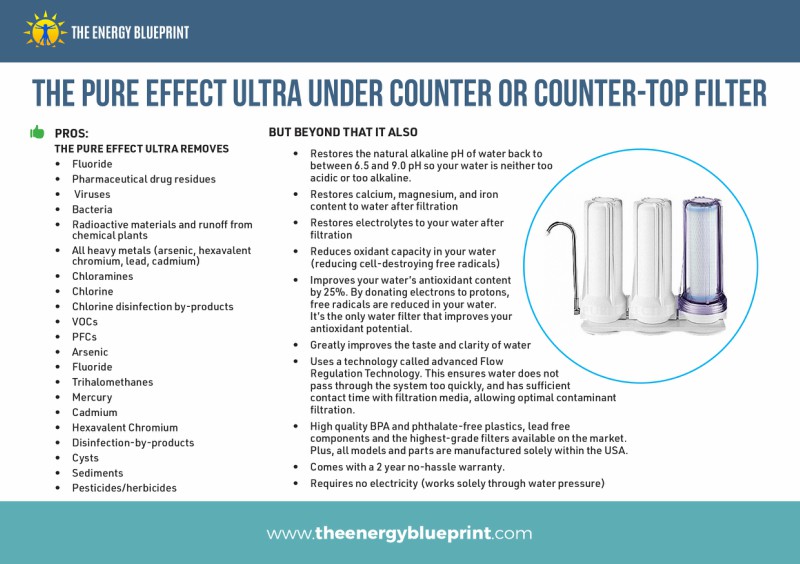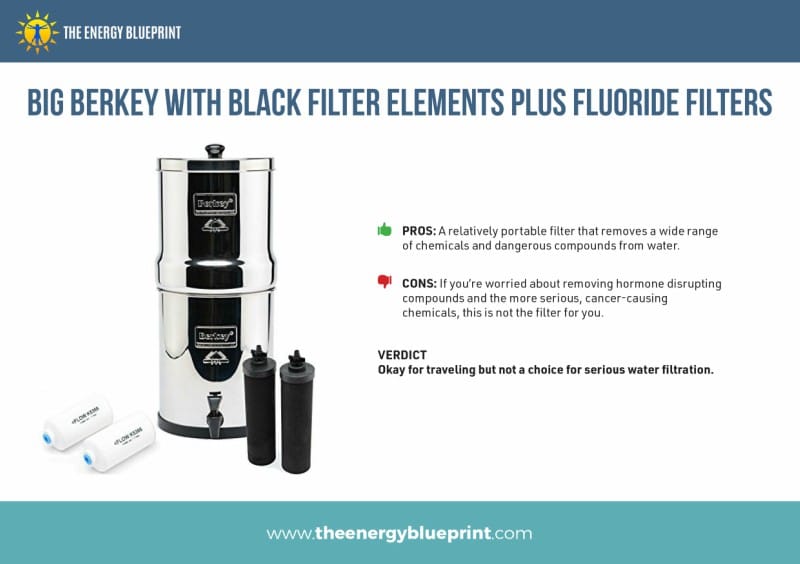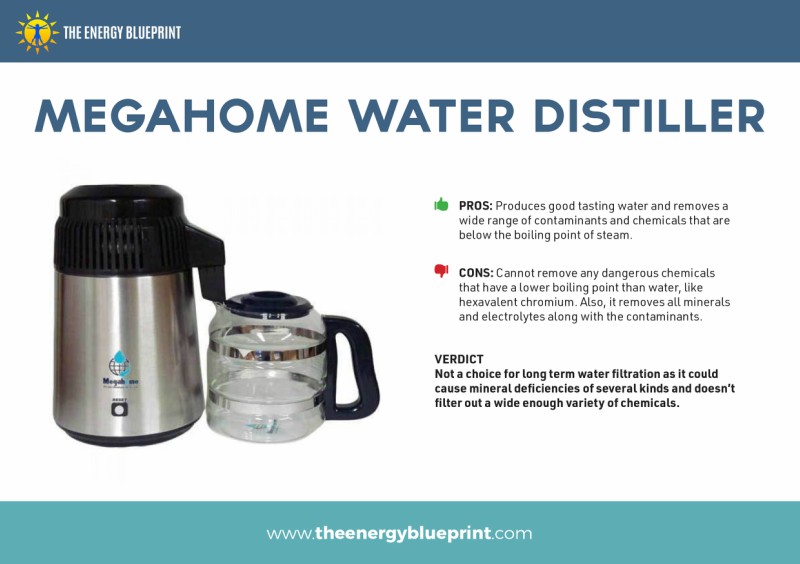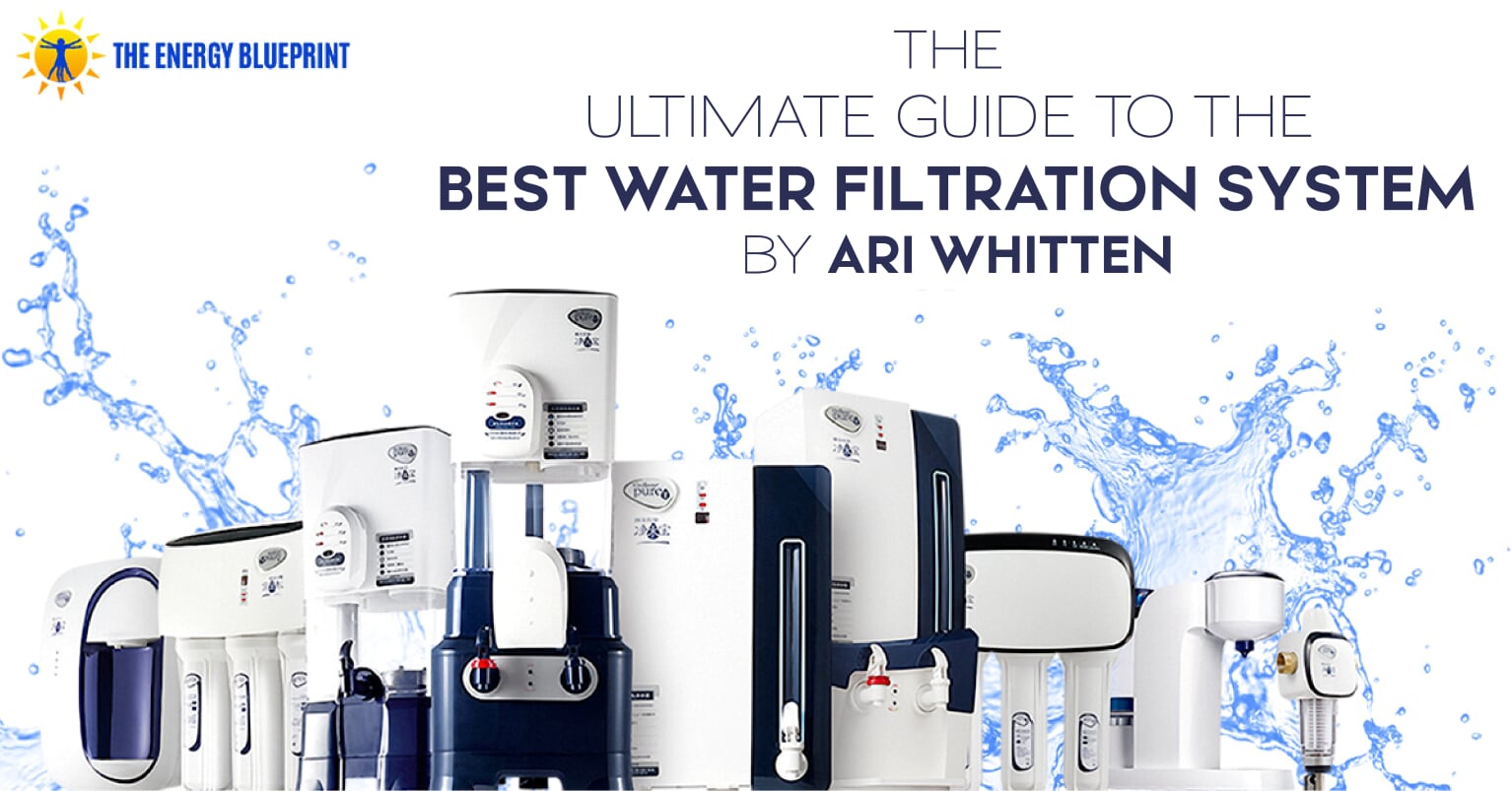 Water. We drink it. We brush our teeth with it. We shower in it. And when this water is not filtered adequately, we end up drinking, bathing in, and breathing dangerous disease-causing chemicals every single day. So how do we fix the problem? This article is the ultimate guide to the best water filtration system.
Water. We drink it. We brush our teeth with it. We shower in it. And when this water is not filtered adequately, we end up drinking, bathing in, and breathing dangerous disease-causing chemicals every single day. So how do we fix the problem? This article is the ultimate guide to the best water filtration system.
Most people don’t realize it, but drinking improperly filtered tap water is actually a major source of disease-causing and fatigue-inducing toxins.
This isn’t meant to be fear-mongering – it’s just a fact that tap water is loaded with chemicals known to cause harm to human health (including the development of cancer) and chemicals which are known to directly damage your mitochondria (the energy generators in your cells). And this isn’t just theory — these chemicals are indeed getting into our blood and our cells.
In this article, I’m going to show you all the science of what is actually in our water. And more importantly, I’m going to give you the ultimate science-based guide to the best water filters to get these chemicals OUT of your water so you can protect your health and your family’s health.
Welcome To The Ultimate Guide To The Best Water Filtration System
Drinking tap water can expose you to a wide range of dangerous chemicals, many of which have not even been identified yet—and none of which scientists have studied the combined effects of. No one’s studying “what happens when benzene’s mixed with hexavalent chromium and fluoride,” for example. We can look at safety studies and levels of what is considered to be relatively safe for a particular compound, but all such studies are done on single isolated chemicals. No one is studying the effects of people consuming small amounts of literally dozens of chemicals every day, multiple times a day. There’s the real danger.
Just to give you a little sense of how big of an issue this is, consider this…
Even after the overwhelming success of the movie Erin Brockovich, which not only alerted Americans but the entire world to the dangers of hexavalent chromium in water, over 200 million Americans are still showering in water and drinking water with hexavalent chromium in it that has been shown to cause cancer even at very low doses (like is in many people’s tap water supply).
As the Environmental Working Group (EWG) notes,
“But almost 25 years after that real-life confrontation [referring to the Erin Brockovich movie] the conflict over chromium-6 is not over. A new EWG analysis of federal data from nationwide drinking water tests shows that the compound contaminates water supplies for more than 200 million Americans in all 50 states.
Yet federal regulations are stalled by a chemical industry challenge that could mean no national regulation of chemical state scientists in California and elsewhere say causes cancer when ingested at even extraordinarily low levels.”[1]
(**Note, the EWG just recalculated that total at 250 million. You can see all the cities and utility companies with the highest levels of hexavalent chromium at the EWG’s Tap Water Database.)
And that’s just to name ONE of several dozen problematic chemicals in the water supply. So, there’s still plenty more bad news to come about the chemicals in your water supply.
Fortunately, the news isn’t all bad. Here’s the good news: Today, you can purchase certain water filtration systems that remove every single dangerous chemical from your home water supply, to protect you and your family from diseases, cancer, hormone disorders, metabolic disorders, cellular damage, organ damage, and diabetes.
Be aware though, most filters on the market only filter out some harmful chemicals, but not all (and in the case of many popular filter systems, not even most chemicals!)
Just How Dangerous Is Your Tap Water?
Today, in America, people are taking in huge amounts of toxic chemicals because they’re drinking and showering in unfiltered tap water. An average glass of tap water anywhere in America has over 350 dangerous chemicals in it.[2]
Almost ten years ago now, in a 2009 Environmental Working Group (EWG) test of 20 million tap water samples, scientists found a total of 316 toxic chemicals, including pesticides, weed killers, solvents, and a chemical used to manufacture rocket fuel called “perchlorate.” [3] These 20 million samples came from water all over America between 2004 and 2009.
More recently, the EWG collected data from both the EPA and state agencies nationwide, tallying results of water tests conducted across the nation, from 48,712 utility companies in all 50 states.
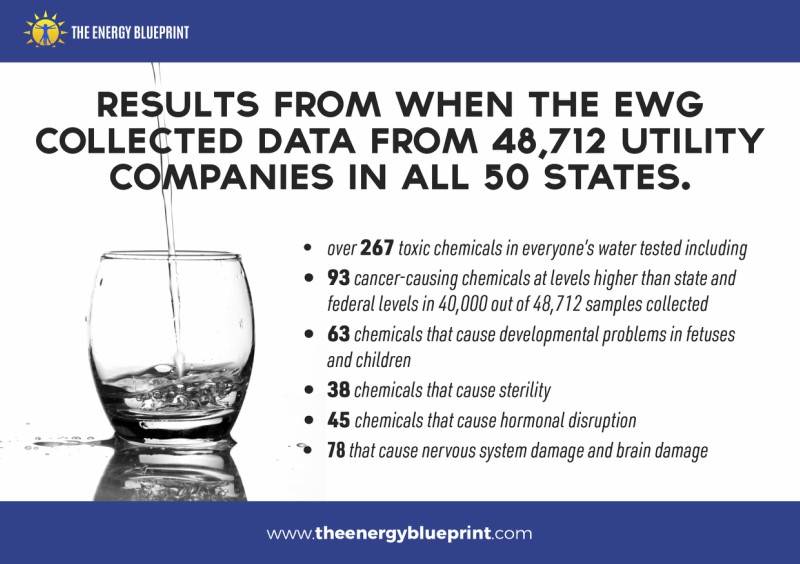
The EWG found over 267 toxic chemicals in everyone’s water tested including:
- 93 cancer-causing chemicals at levels higher than state and federal levels in 40,000 out of 48,712 samples collected
- 63 chemicals that cause developmental problems in fetuses and children
- 38 chemicals that cause sterility
- 45 chemicals that cause hormonal disruption
- 78 that cause nervous system damage and brain damage[4]
In the EWG’s article State of American Drinking Water, the author notes that
“When most Americans drink a glass of tap water, they’re also getting a dose of industrial or agricultural contaminants linked to cancer, brain and nervous system damage, developmental defects, fertility problems or hormone disruption.”[5]
This is a very big deal – a HUGE source of disease-causing chemicals getting into our bodies – that virtually no one is talking about.
The problem is that most states and the Safe Drinking Water Act have set their limits for these chemical contaminants higher than levels that are dangerous to human health—higher than scientific studies have found causes health risks.
This means that you won’t be warned about “unsafe” chemicals in drinking water even though you’re being exposed to dangerous levels of them!
Another problem is many chemicals in tap water are not regulated. There are hundreds of chemicals in our water that we don’t even know about. Chemicals we haven’t named or studied for their health effects. So, the chemicals that we do have studies on are likely just scratching the surface of that amount of harm being done to our health.
Furthermore, there is the issue that, even if certain chemicals in our water are regulated – for example, benzene or hexavalent chromium – what about the combined effects of arsenic and hexavalent chromium, or benzene, hexavalent chromium, and arsenic?
Just as you cannot combine bleach and ammonia, what happens to us when we shower in water contaminated with benzene, hexavalent chromium, aluminum, chlorine, chlorinated by-products, lead, and arsenic? Chlorine and ammonia, for example, form chloramine, which is far more toxic (and hard to filter from the water supply) than either chlorine or ammonia alone.
It’s a frightening thought, isn’t it?
Even if we might think of the stomach lining as stronger than it is and brag to our friends that we have an “iron stomach,” we most certainly do not. Chemicals like volatile organic compounds (VOCs) pass through our intestinal lining into our bloodstream and begin their work at a cellular level, altering DNA and potentially contributing to cancer.[6]
Even worse, many people don’t realize that this isn’t just about the water we drink, but water vapors in the shower can be an even greater risk. Inhaling these chemicals when we shower sends them straight into our respiratory system and cells, where they can do massive cellular damage, gene damage, DNA damage, all the kinds of cellular damage that cause cancer.
As Lance Wallace of the EPA notes,
“Showering is suspected as the primary cause of elevated levels of chloroform in nearly every home because of the chlorine in the water. Chloroform [a known carcinogen] levels increase up to 100 times during a 10-minute shower in residential water.”[7]
Why You Cannot Trust Your City Officials To Provide You With Safe Water
Sometimes when people talk about filtering their water in their, people are confused, because they are under the impression that the city already purifies the water so it’s safe. It’s common for people to be baffled by talk of buying a water filtration system and say “I really don’t know why you would need such a thing. The city government purifies our water.”
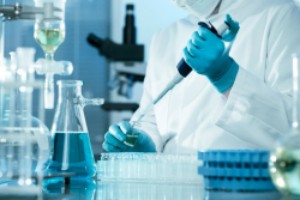 This brings up an important distinction. Yes, your government DOES filter and purify the water of the whole city, but please realize that they do NOT actually see their role as providing all the citizens with water free of chemicals. They see their role as largely as a matter of making sure levels of some specific compounds (e.g. lead) are relatively low, but mainly they see their role as being to STERILIZE the water of pathogens like bacteria, viruses, and parasites that can spread disease. And in fact, they do this sterilization of water by ADDING many chemicals to the water supply! So yes, the city does certain processes to purify and sterilize the water, and they do indeed solve some issues, but also cause other issues in the process.
This brings up an important distinction. Yes, your government DOES filter and purify the water of the whole city, but please realize that they do NOT actually see their role as providing all the citizens with water free of chemicals. They see their role as largely as a matter of making sure levels of some specific compounds (e.g. lead) are relatively low, but mainly they see their role as being to STERILIZE the water of pathogens like bacteria, viruses, and parasites that can spread disease. And in fact, they do this sterilization of water by ADDING many chemicals to the water supply! So yes, the city does certain processes to purify and sterilize the water, and they do indeed solve some issues, but also cause other issues in the process.
If you’re now thinking “but surely they’ve tested all these chemicals in the water and know they are safe,” well, unfortunately, that is just not the case. I wish it were the case, but it’. Again, many of those chemicals they add to the water supply are associated with numerous diseases and have known toxicity to humans. But this is all considered part of what needs to be done to sterilize the water supply of pathogens.
And while sterilizing the water of pathogens is of course, extremely important, this treatment unfortunately still leaves us with water filled with disease-causing compounds of other sorts. So, we still need another step in purifying our water – in our homes.
This assumption that our city water is perfectly safe because the city purifies it, is, unfortunately, a very common belief. Most people simply have no idea about all the nasty toxins in their water supply.
So how do you find out what chemicals are in your water? The EPA has a website called the EWG’s Tap Water Database where you can plug in your zip code and check exactly what dangerous chemicals are in your particular water system so that you can make sure to choose a water filter which can effectively remove these.
The dangerously high limits set for cancer-causing chemicals in your water
To explain this in the simplest terms possible. The EPA sets two limits for pollutants in water. An ideal safe level (which is called the Maximum Contaminant Level Goal, MCLG) and an “enforceable level” (the Maximum Contaminant Level, MCL), which is always set much higher than the ideal safe level.
The enforceable level is the level that is actually set since filtering out all chemicals and pollutants would be extremely expensive.
Just as one example of this, arsenic is a known carcinogen and it’s found in every single public water system in the United States. The ideal MCLG for arsenic is 0, or in scientific terms, 0.00. The enforceable MCL is 0.1. This means your water can contain some arsenic without the need for (expensive) action on the part of water companies and no need to alert the public.[8]
So be aware that your water is almost certainly FULL of dozens of low levels of dozens of known carcinogens and other disease-causing chemicals. As long as they are below the MCL, the city will allow all those chemicals to be in the water.
Where do the chemicals in our water come from?
You might be wondering, “where the heck do all these chemicals come from, and how do they get in our water?”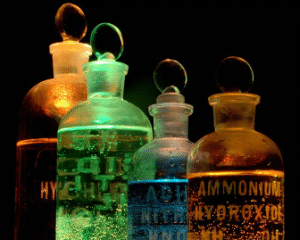
The chemicals found in tap water come from a wide variety of sources. For one, there is the pipes the water runs through. These can leach dangerous chemicals from aging infrastructures and rusting pipes into our water. Especially old lead pipes.
Then there is the problem of run-off from chemical plants, manufacturing, industry, and agriculture, prescription drug residues, minute pieces of plastics rich in hormone-disrupting chemicals, pesticides, heavy metals, fluoride, chlorine, and the list goes on and on.
There are also chemicals that are particular to one’s area.
If you live near an old power plant, you may have all kinds of radioactive chemicals leaching into your water. If you live near large farms, you could have dangerous pesticides and nitrates leaching into your water.
If you live near an industrial area, you could be exposed to dangerous volatile organic chemicals (VOCs) in tap water, which are a wide array of dangerous chemicals like benzene that are created during manufacturing virtually everything. For example, we get benzene in our water from the discharge from factories and the runoff from gas storage tanks and landfills. We get atrazine from herbicides used on crops and their runoff.
Then there’s Benzo(a)pyrene (PAHs), which come from the lining in water tanks and lines. (For more on this, and regulated and unregulated VOCs in our tap water, see DrinkTap.org’s VOC page or the EPA’s National Drinking Water Regulations site.)
So in short, there are lots of different environmental sources for these chemicals, but certainly, industry and agriculture are major contributors.
Perfluorocarbons (PCBs)
 For 15 million Americans in 27 states in America, their water is polluted with a very dangerous chemical called perfluorocarbons (PFCs) a toxic chemical that was used to manufacture non-stick cookware (e.g. Teflon cookware), firefighting foam, outdoor clothing, and food packaging materials.
For 15 million Americans in 27 states in America, their water is polluted with a very dangerous chemical called perfluorocarbons (PFCs) a toxic chemical that was used to manufacture non-stick cookware (e.g. Teflon cookware), firefighting foam, outdoor clothing, and food packaging materials.
PFCs have been found to cause cancer, thyroid disorders, and damaged immune systems.
These are some of the most dangerous chemicals of all that you may be exposed to in water.
You can learn more about the states and cities that are most contaminated at the EWG’s Guide to Avoiding PFCs, where you can put in your zip code and find out if you are near a contamination site. See the EWG’s Mapping Contamination Crisis page here.
Chlorine and Chloramines
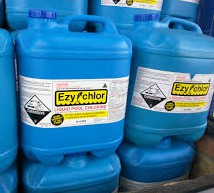 Adding to this lethal mixture, cities disinfect water with dangerous chemicals like chlorine. Chlorine works quite effectively to deal with microorganisms in the water, but it also is not very kind to human cells.
Adding to this lethal mixture, cities disinfect water with dangerous chemicals like chlorine. Chlorine works quite effectively to deal with microorganisms in the water, but it also is not very kind to human cells.
I want to leave you with a quote from an article published in 1995 titled “Drinking Water and Cancer” in the journal Environmental Health Perspectives:
“The use of chlorine for water treatment to reduce the risk of infectious disease may account for a substantial portion of the cancer risk associated with drinking water. The by-products of chlorination are associated with increased risk of bladder and rectal cancer, possibly accounting for 5000 cases of bladder cancer and 8000 cases of rectal cancer per year in the United States. … We need more cost-effective methods for monitoring drinking-water quality and further research on interventions to minimize cancer risks from drinking water.”
Moreover, today, most microorganisms that lurk in water, like dangerous bacteria such as listeria, have become resistant to chlorine. To compensate for that, we’re now using even more dangerous chloramines (chlorine + ammonia and/or other chemicals) to disinfect our water – and chloramines have been proven to cause a wide range of cancers including bladder a[9]nd rectal cancer.[10]
Trihalomethanes and DBPs
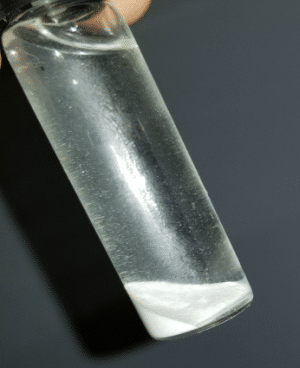 When chlorination products combine with organic matter, they create a dangerous chemical called organic trihalomethane byproducts (Disinfection by-products, or DBPs) of chlorination which are actually even more toxic than chlorine, causing liver damage, kidney, and intestinal cancers in rodents, central nervous system disorders, sterility, and anemia and are especially dangerous when inhaled (i.e. during showering).[11]
When chlorination products combine with organic matter, they create a dangerous chemical called organic trihalomethane byproducts (Disinfection by-products, or DBPs) of chlorination which are actually even more toxic than chlorine, causing liver damage, kidney, and intestinal cancers in rodents, central nervous system disorders, sterility, and anemia and are especially dangerous when inhaled (i.e. during showering).[11]
When I asked water expert Igor Milevsky about chlorine disinfection byproducts, he responded that we probably don’t even know half the story:
“There is certainly that issue, the trihalomethanes, haloacetic acids, all these types of chemicals, chloroform. These are all formed as a byproduct of chloramine. As I was mentioning before, when chemicals mix together they create other things, other byproducts. They’re being discovered, new ones are coming out all the time. The more you look, the more you will find.”
Volatile Organic Chemicals
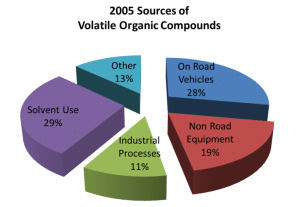 VOCs are carbon-containing chemicals that evaporate easily and can easily soak into the ground and carried deeper into an aquifer. VOCs are found in all city water sources and have even been found in some well water. VOCs can include pesticides, herbicides, and other chemicals used in industry. There are currently 23 of these chemicals that are regulated. Of these 23, eight are known human carcinogens. Two examples are:
VOCs are carbon-containing chemicals that evaporate easily and can easily soak into the ground and carried deeper into an aquifer. VOCs are found in all city water sources and have even been found in some well water. VOCs can include pesticides, herbicides, and other chemicals used in industry. There are currently 23 of these chemicals that are regulated. Of these 23, eight are known human carcinogens. Two examples are:
- Tetrachloroethylene: a solvent used in all kinds of industrial processes.
- Benzene: another solvent found in petroleum products, alcohols, and gasoline.
According to the U.S. National Library of Medicine, VOCs can cause eye irritation, nose and throat irritation, headaches, nausea, allergic skin reactions, fatigue, dizziness, and damage to the kidneys, liver, and CNS.[12], [13],[14]
VOCs (Volatile Organic Compounds)
Well water: Very vulnerable to VOCs
 First, there’s a big danger in drinking well water that may be contaminated with VOCs — especially if you live near industrial areas, power plants, and large industrial farms. Well water is particularly vulnerable to VOCs. That’s because rain can push VOCs deeper and deeper into the soil and, then the water table, where they can leach into well water.
First, there’s a big danger in drinking well water that may be contaminated with VOCs — especially if you live near industrial areas, power plants, and large industrial farms. Well water is particularly vulnerable to VOCs. That’s because rain can push VOCs deeper and deeper into the soil and, then the water table, where they can leach into well water.
If you live on well water, it is important to have your well water tested often for dangerous chemicals of all kinds and especially, an entire spectrum of VOCs. Again, check the links above for lists of these chemicals.[15]
Tap Water and VOCs
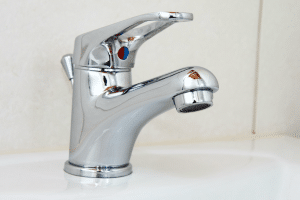 Every city’s public water system is different. When the amount of VOCs in a city’s water reach a toxic level, the city issues a water alert. Currently, of the 30 known VOC in existence, 23 of these chemicals are regulated and 7 VOCs are still unregulated.
Every city’s public water system is different. When the amount of VOCs in a city’s water reach a toxic level, the city issues a water alert. Currently, of the 30 known VOC in existence, 23 of these chemicals are regulated and 7 VOCs are still unregulated.
To find out what VOCs your city’s water may contain, check with your community water provider.
Some communities even test for the 7 unregulated VOCs as part of the Third Unregulated Contaminant Monitoring Rule. Water providers then publish what are called “confidence reports” on the web and, if not, you can request a printed copy from them as well.
There are water filtration systems designed to filter out VOCs. We’ll discuss these in my recommended water filters area…
Radioactive Chemicals
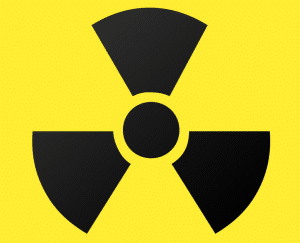 Radioactive compounds? In the water supply? Really?
Radioactive compounds? In the water supply? Really?
Yes! It turns out – despite the fact that virtually no one is talking about this – that there are even radioactive compounds in the water supply. When I spoke with water expert Igor Milevsky, I expressed shock when he pointed this out. He replied:
“Because you are assuming that where would it come from? Because there are no nuclear meltdowns in the US, everything should be fine. There’s a lot of research that shows that as many as 80% of the nuclear power plants in the US, and there is as many as 100 I believe, or a little more than 100 of them, are leaking because they’re old and they’re not well-maintained. They’re leaking into the environment which can eventually end up in the water supply. You can also have naturally occurring radioactive contaminants, if you’re on well water, like radon or uranium for example. Those are naturally occurring in the earth. That can come from the ground. Then you also have fallout radiation from nuclear weapons testing or things like Fukushima in Japan. Winds blow that over here. There’s certainly a concern for that and there’s a need to have the water filter address that.”
According to the Environmental Working Group,
“Drinking water for more than 170 million Americans in all 50 states contains radioactive elements that may increase the risk of cancer, according to an EWG investigation released today. Radiation in tap water is a serious health threat, especially during pregnancy, and the Environmental Protection Agency’s legal limits for the most widespread radioactive elements are more than 40 years old.”[16]
It’s important to note here that most filters do NOT effectively filter out radioactive compounds.
Prescription and Over-The-Counter Drug Residues
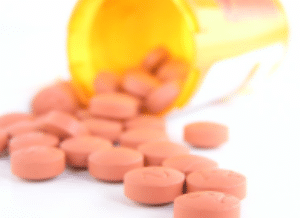 Yet another problem is wastewater contaminated with prescription and over-the-counter drugs (and drug metabolites), from people urinating and defecating, as well as people simply flushing drugs down the toilet. Whenever these wastewater runoffs meet with surface water, they are able to get into groundwater and contaminate the city water supply. Unfortunately, sewage treatment plants do not effectively remove pharmaceutical drug residues from the water supply.
Yet another problem is wastewater contaminated with prescription and over-the-counter drugs (and drug metabolites), from people urinating and defecating, as well as people simply flushing drugs down the toilet. Whenever these wastewater runoffs meet with surface water, they are able to get into groundwater and contaminate the city water supply. Unfortunately, sewage treatment plants do not effectively remove pharmaceutical drug residues from the water supply.
Indeed, these compounds are now detectable in our water supply. That is, when you drink tap water, you are actually getting minute amounts of various prescription and over-the-counter drugs (as well as drug metabolites that have already passed through someone else’s body).
According to Harvard Health
“Reliable figures are hard to come by, but it’s a safe assumption that we, as consumers, are responsible for a hefty percentage of the pharmaceutical and personal care products that wind up in lakes, rivers, and streams. The typical American medicine cabinet is full of unused and expired drugs, only a fraction of which get disposed of properly. Data collected from a medication collection program in California in 2007 suggest that about half of all medications — both prescription and over-the-counter — are discarded. …
Chemicals also get into the water from the drugs we use. Our bodies metabolize only a fraction of most drugs we swallow. Most of the remainder is excreted in urine or feces (some is sweated out) and therefore gets into wastewater. …
Healthcare institutions are another source of pharmaceutical water pollution. …
Agriculture is another major source. The two trillion pounds of animal waste generated by large-scale poultry and livestock operations in this country is laced with hormones and antibiotics fed to animals to make them grow faster and to keep them from getting sick. Inevitably, some of those hormones and antibiotics leach into groundwater or get into waterways.”[17]
But just how bad is the problem?
“A study conducted by the U.S. Geological Survey in 1999 and 2000 found measurable amounts of one or more medications in 80% of the water samples drawn from a network of 139 streams in 30 states. The drugs identified included a witches’ brew of antibiotics, antidepressants, blood thinners, heart medications (ACE inhibitors, calcium-channel blockers, digoxin), hormones (estrogen, progesterone, testosterone), and painkillers. Scores of studies have been done since.
Other drugs that have been found include caffeine (which, of course, comes from many other sources besides medications); carbamazepine, an antiseizure drug; fibrates, which improve cholesterol levels; and some fragrance chemicals (galaxolide and tonalide).”[18]
Now, it’s true that these compounds are only in the water in small amounts. While the direct effect of this on human health still hasn’t been studied, we do know that it’s already known to affect fish health, and it’s not unreasonable to imagine that consuming small amounts of dozens of chemicals day after day for years could eventually cause detrimental health effects.
Do you want to take that chance and wait for the research to see if all these drug residues are safe, or do you want to take action to get them out of your water?
Given the risk to reward of both of those options, I think the answer is obvious.
Fluoride
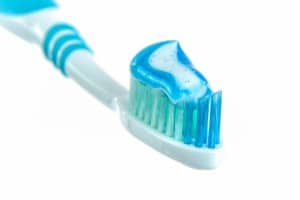 Think about this for just a moment. Fluoride is a known neurotoxin that numerous studies have shown to cause brain damage.
Think about this for just a moment. Fluoride is a known neurotoxin that numerous studies have shown to cause brain damage.
Yet, simultaneously fluoride is added to our drinking water. (With the idea that it will help protect the enamel on our teeth).
Let that sink in for just a moment. The government is trying to protect our dental health by adding a known neurotoxin to the water supply.
As reported in Harvard Health, researchers analyzed the fluoride levels in drinking water of different areas in order to determine if there was a possible effect of fluoride on brain development in children. Here’s what they found:
“Choi and senior author Philippe Grandjean, adjunct professor of environmental health at HSPH, and their colleagues collated the epidemiological studies of children exposed to fluoride from drinking water. The China National Knowledge Infrastructure database also was included to locate studies published in Chinese journals.
They then analyzed possible associations with IQ measures in more than 8,000 children of school age; all but one study suggested that high fluoride content in water may negatively affect cognitive development.
The average loss in IQ was reported as a standardized weighted mean difference of 0.45, which would be approximately equivalent to seven IQ points for commonly used IQ scores with a standard deviation of 15.*
Some studies suggested that even slightly increased fluoride exposure could be toxic to the brain. Thus, children in high-fluoride areas had significantly lower IQ scores than those who lived in low-fluoride areas.
The children studied were up to 14 years of age, but the investigators speculate that any toxic effect on brain development may have happened earlier, and that the brain may not be fully capable of compensating for the toxicity.
‘Fluoride seems to fit in with lead, mercury, and other poisons that cause chemical brain drain,” Grandjean says. ‘The effect of each toxicant may seem small, but the combined damage on a population scale can be serious, especially because the brain power of the next generation is crucial to all of us.’”[32]
Now, it would be at least partially understandable that we’re fluoridating the water supply if the research showed strong benefits on dental health. But even there, the research doesn’t support that notion strongly either. In fact, in areas of the world where they have stopped fluoridation, dental caries have gone down—not up. In Japan, for example, they discontinued fluoridation in the 1970s,[33] and cavities have declined. In the Netherlands, fluoridation was discontinued in 1973, and rates of cavities have declined.[34]
Individuals are just now mobilizing to demand this discontinuation of fluoride in communities across the U.S.A.. About 130 communities in America have won this fight so far and had fluoridation stopped in their community. You can contact the Fluoride Action Network for help getting started.
If you want to watch a really good documentary on the real health dangers posed by fluoridated water, try the documentary Fluoride: Poison on Tap. You can stream it here.
Here are some facts:
- Fluoride can cause many adverse health effects, especially long term. In 2006, the EPA recommended that the MCLG of fluoride in drinking water be lowered because of increased risk of increased bone fractures in children from infancy to 8 years old.
- Increased risk of dental enamel fluorosis in children.[35]
But that’s just scratching the surface. The health risks of (consuming) fluoride include:
- Kidney disease. According to researchers, it only takes .2mg/L of fluoride to cause kidney damage in children. Again, our acceptable level is still .4 mg/L.[36], [37],[38]
- Brittle, weak bones. Skeletal fluorosis can result from long-term fluoride consumption. The liver cannot filter fluoride properly, so it stays in the blood and then combines with calcium (which it pulls from the bones).[39],[40],[41]
- Arthritis. Fluoride causes calcification of the arteries and joints and tissues in the joints. Degenerative osteoarthritis and fluorosis are linked in several studies.[42],[43],[44]
- Thyroid damage. Iodine and fluoride are molecularly similar enough the thyroid can “take up” fluoride instead of iodine. Fluoride causes thyroid cell death and inhibits thyroid function. Fluoride is often used to curb thyroid activity for hyperthyroidism.[45], [46], [47] Believe it or not, fluoride is actually given as a treatment to people with hyperthyroidism (that’s too MUCH thyroid hormones) in order to switch off the thyroid gland. And consider this: The amount of fluoride in a single glass of tap water is enough to cause a significant amount of thyroid inhibition. Here’s Thyroid expert Izabella Wentz, PharmD on that: “Fluoride is effective as a thyroid suppressor at doses of 0.9-4.2 mg per day for hyperthyroidism. Most adults in fluoridated communities are ingesting between 1.6 and 6.6 mg of fluoride per day from water inadvertently suppressing their thyroid function!”[48]
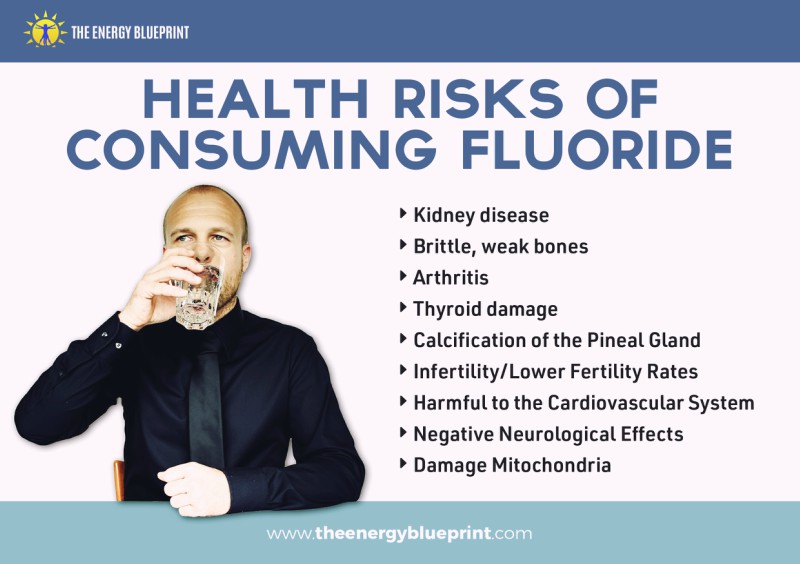
- Calcification of the Pineal Gland. Many elderly persons suffer from chronic sleeplessness. Researchers now believe fluoride exposure over time causes this, since fluoride calcifies the pineal gland, impacting sleep/wake cycles.[49]
- Infertility/Lower Fertility Rates. A direct link exists between fertility rates and fluoridated drinking water. Higher levels of fluoride correspond to lower fertility rates, particularly with drinking water levels of 3 ppm.[50],[51]
- Harmful to the Cardiovascular System. Research suggests that exposure to fluoride inflammation of the heart and atherosclerosis.[52], [53]
- Negative Neurolgical Effects. Fluoride is classified as a neurotoxin. The Fluoride Action Network has collected 43 studies that prove that fluoride negatively impacts cognitive development and lowers IQ in the young.[54],[55]
- Damage Mitochondria: Fluoride is also directly involved in damaging and inhibiting energy production in the mitochondria.[56], [57], [58] For anyone with fatigue, this is very bad news. Deteriorating mitochondrial health is also now being tied to numerous other chronic diseases and even aging itself.
**I highly recommend The National Research Council of the National Academies’ Committee on Fluoride’s 400-page review of all health conditions connected to fluoride exposure here.
Endocrine Disruptors in Tap Water
You’ve probably heard of endocrine disrupting chemicals (EDCs) in our water and environment by now and how these mimic and intensify the effects of our natural hormones or block the effect of our natural hormones. Endocrine disruptors enter our water supply through a vast array of sources from pesticides, to micron-sized plastics which contains BPA or BPA derivatives like BPS (often in “BPA-free” plastics) which is just as hormone-disruptive as BPA.
Endocrine disruptors contribute to obesity, and likely many other hormone-related health problems. Note: studies find that even trace amounts of EDCs “affect obesity-related pathways by changing hormone levels or altering gene expression.”[59]
Pesticides, herbicides, pollutants, polychlorinated biphenyls, dioxins, and phthalates all cause hormone disruption as well. Of course, drinking bottled water is not the answer here as plastics of all kinds are very rich in hormone-disrupting BPA/BPS, so bottled water will also have these hormone disruptors.
The only answer is a good water filtration system that removes endocrine disruptors from your water and to drink water out of glass containers only.
***Note: many types of water filters do not remove endocrine disruptors and may even let micron-sized plastics into your water, containing BPA and other chemicals.
Heavy Metals in Our Water
Heavy metals are a big problem in drinking water and enter our water system through all kinds of processes.
Industrial processes such as electroplating, metalwork, and any chemical industries create runoff that leaches into soil and water systems. Industrial and agricultural wastewater is a huge source of heavy metals in water as well as traffic emissions, which contain mercury and lead.
The effects of heavy metal exposure are deadly and can lead to organ damage, nervous system damage, cancer of the liver, bladder, and kidneys and can trigger a wide range of autoimmune diseases where the body attacks its own tissues in an effort to rid the body of these dangerous chemicals.[19]
Examples of heavy metals that can leach into tap water include
- arsenic
- cadmium
- hexavalent chromium
- lead
- thallium
- mercury
Of these heavy metals, the most prevalent heavy metal in America’s tap water is hexavalent chromium.
Arsenic, which is equally deadly, runs a close second.[20]
Arsenic
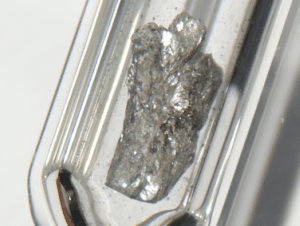 Arsenic is a very dangerous metal that is still highly present in water samples all over America. In China, arsenic in water causes a type of gangrene called Blackfoot disease.[21]
Arsenic is a very dangerous metal that is still highly present in water samples all over America. In China, arsenic in water causes a type of gangrene called Blackfoot disease.[21]
Inorganic arsenic is a confirmed carcinogen and is the most prevalent chemical contaminant in drinking-water globally.[22]
The International Agency for Research on Cancer (IARC) clearly states that “arsenic in drinking-water is carcinogenic to humans” and can cause other deadly diseases such as diabetes, heart disease, pulmonary disease, and cardiovascular disease.
Drinking water supplies for 70 million Americans in 48 states are contaminated with arsenic at concentrations above the level scientists say increases the risk of cancer, according to nationwide test results collected in EWG’s Tap Water Database.[23]
Lead
There have been some recent incidents of massive lead contamination in the water supply that have garnered lots of media attention. But many people don’t realize that small amounts of lead consumed in water and food over years and decades can result in serious health issues like brain issues, mitochondrial damage, and hormonal problems.
Hexavalent Chromium
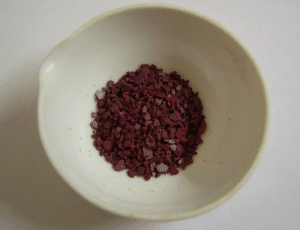 If you remember the movie Erin Brockovich, you already know something about the problem of hexavalent chromium, and how one small town in California suffered from thousands of cases of cancer from being exposed hexavalent chromium in their water.
If you remember the movie Erin Brockovich, you already know something about the problem of hexavalent chromium, and how one small town in California suffered from thousands of cases of cancer from being exposed hexavalent chromium in their water.
But did you know that, according to the EWG, over 75% of U.S. drinking water contains hexavalent chromium?[24] This means that over 200 million Americans drink water with this heavy metal in it every day–or inhale it via shower steam or absorb it into their skin.
Hexavalent chromium enters our water supply by way of pollution and runoff from a variety of industrial manufacturing processes. The metal enters our water from both the air pollution and discharge from factories of all kinds.
Back in 2010, the carcinogenic compound was found in 31 of 35 U.S. cities analyzed by the Environmental Working Group (EWG).[25]
Hexavalent chromium (chromium-6) is classified as a Group 1 carcinogen by the World Health Organization.[26] What this means is that—without a doubt – hexavalent chromium causes cancer.
Even in minute amounts, the compound is a significant risk to human health. Scientists in California, have labeled it a carcinogenic compound even in concentrations of .02 parts per billion.[27]
The scary part is that the majority of public water suppliers out there don’t actually have to remove hexavalent chromium from the city water supply. You see, in most cities, the acceptable limit is for hexavalent chromium is set ridiculously high so no action will have to be taken. No money will have to be spent protecting our citizens.
In California, for example, the acceptable limit of chromium-6 is set a whopping 500 times higher than the level researchers say is dangerous for human consumption — in fact, 500 times higher than it has been proven to cause cancer in animals.
In animal studies, hexavalent chromium has been found to cause cancer even at the level of .02 parts per billion. Yet, the California standard is 10 parts per billion.[28]
As Vice President of the Environmental Working Group, Bill Walker comments, hexavalent chromium is “a poster child for educating people that there are lots of unregulated chemicals in your drinking water, and those chemicals can act in combination to cause cancer in ways that individual chemicals may not.[29]
Who is at the most risk of hazardous amounts of hexavalent chromium exposure?
Hexavalent chromium is used in the manufacturing of textiles, stainless steel, anticorrosion coatings, and in leather tanning. With some careful research, you can find out if there are factories near you that may place you at special risk of exposure and have your water tested for chromium-6 as well.
Those most in danger of hazardous levels of chromium-6 exposure are those people who live near chromium manufacturing and processing plants.[30]
For more information on industries that emit dangerous levels of chromium, see the EPA’s report Locating and Estimating Air Emissions from Sources of Chromium.
According to Clean Water Action,
“there is now strong data linking ingestion of hexavalent chromium, such as through drinking water, to severe health effects. In addition to cancer and reproductive harm, short and long-term exposures can lead to eye and respiratory irritation, asthma attacks, nasal ulcers, dermal burns, anemia, acute gastroenteritis, vertigo, gastrointestinal hemorrhage, convulsions, ulcers, and damage or failure of the liver and kidneys.”[31]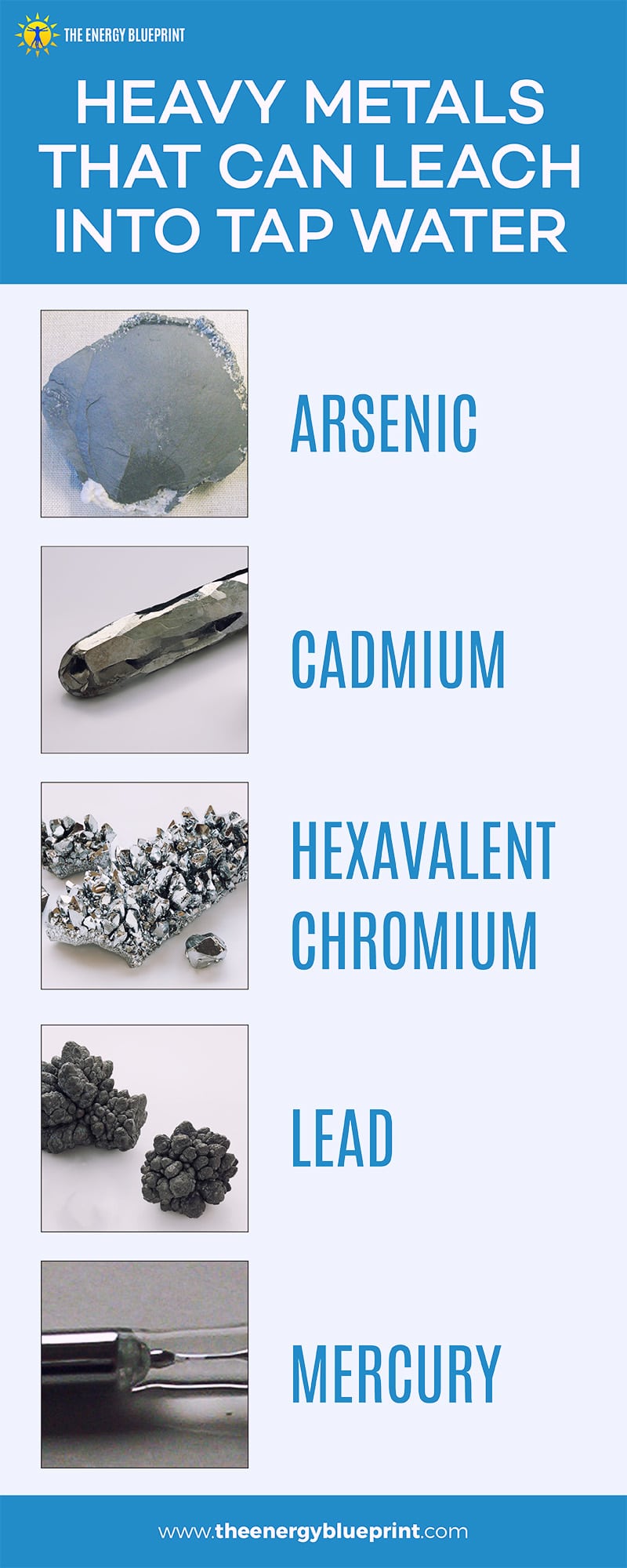
The Best Water Filters to Get Healthy Water
Now, let’s talk about how to get them OUT of the Water. Here is a detailed breakdown of all the different filter types and their pros and cons, along with my recommendations for the best water filtration systems.
Pitcher-Style Water Filteration Systems
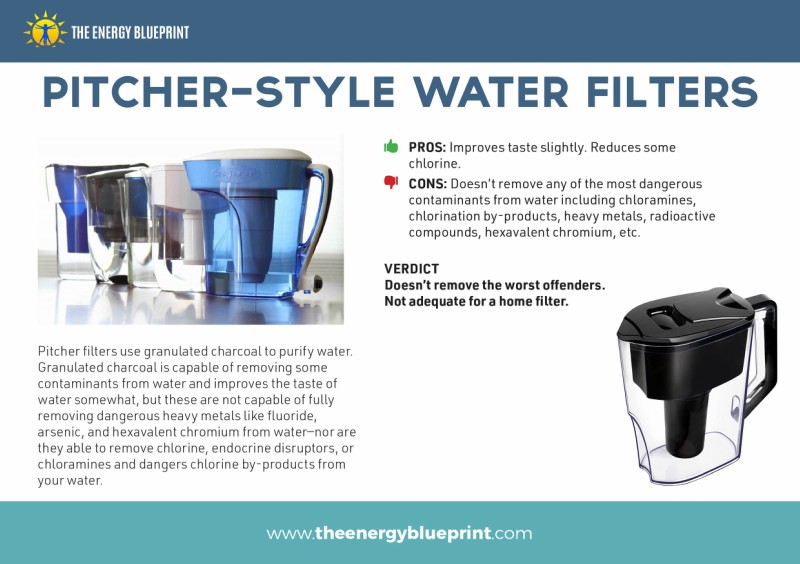
Pitcher filters use granulated charcoal to purify water. Granulated charcoal is capable of removing some contaminants from water and improves the taste of water somewhat, but these are not capable of fully removing dangerous metals like arsenic, lead, mercury, and hexavalent chromium from water—nor are they able to remove all the fluoride, endocrine disruptors, or chloramines and dangerous chlorine by-products from your water.
Although they can reduce the amount of chlorine in your water they cannot remove
- VOCS
- Perfluorocarbons
- heavy metals
- fluoride
- chlorination by-products
Granulated charcoal filters must be refilled often and are pretty expensive, meaning, why not get the best water filtration system that removes more contaminants and costs less money, right?
Pros: Improves taste slightly. Reduces some chlorine.
Cons: Doesn’t remove any of the most dangerous contaminants from water including chloramines, chlorination by-products, heavy metals, radioactive compounds, hexavalent chromium, etc.
Verdict: Doesn’t remove the worst offenders. Not adequate for a home filter.
Reverse Osmosis (RO) Water Filtration Systems
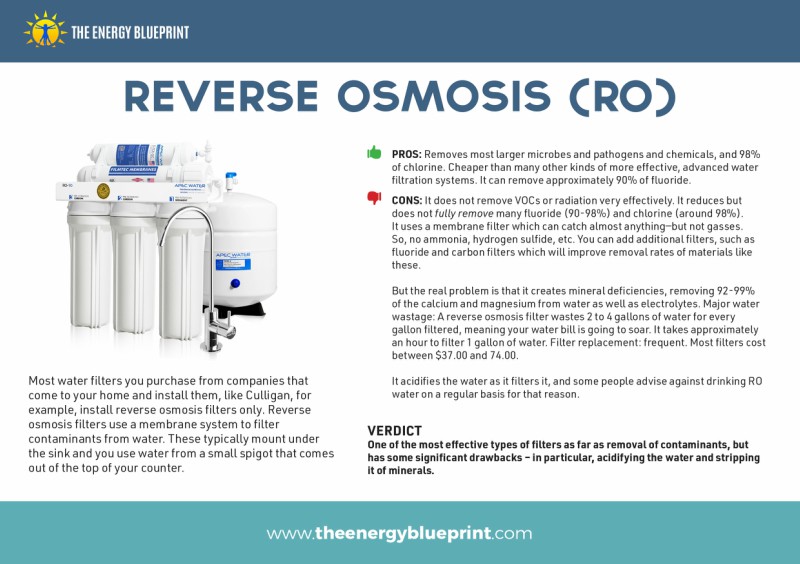
Most water filters you purchase from companies that come to your home and install them, like Culligan, for example, install reverse osmosis filters only. Reverse osmosis filters use a membrane system to filter contaminants from water. These typically mount under the sink and you use water from a small spigot that comes out of the top of your counter.
The major drawback of reverse osmosis filters is that the remove all the nutrients in water along with the microbes and toxins they purify from water. For example, reverse osmosis removes almost all the iron and manganese from your water, meaning even the food you cook in this water will be less nutritious.
In short, reverse osmosis demineralizes water, and the WHO just released a report on their concerns on mineral deficiencies reverse osmosis can cause.[60]
One of the reasons it creates these mineral deficiencies is not only because it pulls these minerals from water, it also pulls more from your system as well.
In fact, reverse osmosis process removes 92-99% of beneficial calcium and magnesium, which has led to the World Health Organization releasing a report stating that RO water “has a definite adverse influence on the animal and human organism.”
Pros: Removes most larger microbes and pathogens and chemicals, and 98% of chlorine. Cheaper than many other kinds of more effective, advanced water filtration systems. It can remove approximately 90% of fluoride.[61]
Cons: It does not remove VOCs or radiation very effectively. It reduces but does not fully remove many fluorides (90-98%) and chlorine (around 98%). It uses a membrane filter which can catch almost anything—but not gasses. So, no ammonia, hydrogen sulfide, etcetera. You can add additional filters, such as fluoride and carbon filters which will improve removal rates of materials like these.
But the real problem is that it creates mineral deficiencies, removing 92-99% of the calcium and magnesium from water as well as electrolytes.
Major water wastage: A reverse osmosis filter wastes 2 to 4 gallons of water for every gallon filtered, meaning your water bill is going to soar. It takes approximately an hour to filter 1 gallon of water. Filter replacement: frequent. Most filters cost between $37.00 and 74.00.
It also acidifies the water as it filters it, and some people advise against drinking RO water on a regular basis for that reason.
Verdict: One of the most effective types of filters as far as removal of contaminants, but has some significant drawbacks – in particular, acidifying the water and stripping it of minerals.
If you want to remineralize each cup of water you drink, RO water can be safe and effective. But again, be aware of the acidic pH and lack of minerals.
Water Distiller Water Filtration Systems
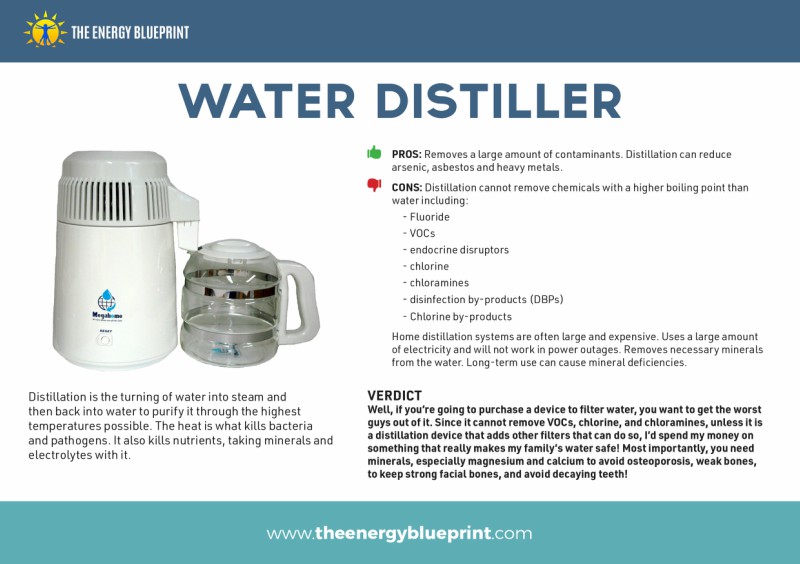
Distillation is the turning of water into steam and then back into water to purify it through the highest temperatures possible. The heat is what kills bacteria and pathogens. It also kills nutrients, taking minerals and electrolytes with it.
This is a great system for killing bacteria and illness-carrying pathogens, but cannot remove most chemicals like VOCs, endocrine disruptors, and chlorine. In general, a distillation device can only remove a chemical that has a higher boiling point than steam — so it misses VOCs, chlorine, chloramines, and DBPs as well. Not what we want.
The distillation process uses heat to cause the water to become steam. So like reverse osmosis, distillation removes calcium, magnesium, iron, and electrolytes out of your water completely.
The steam rises and moves to a cooling area, a chamber. Then, it is turned back into water, but this process also produces some contamination.
This type of filtration reduces large particles like minerals and heavy metals but does not remove endocrine disruptors or VOCs since they vaporize at equal or lower temps that water and rise with the steam. It does effectively kill bacteria.
Pros: Removes a large amount of contaminants. Distillation can reduce arsenic, asbestos and heavy metals.
Cons: Distillation cannot remove chemicals with a higher boiling point than water including:
- Fluoride
- VOCs
- endocrine disruptors
- chlorine
- chloramines
- disinfection by-products (DBPs)
- Chlorine by-products
Home distillation systems are often large and expensive. Uses a large amount of electricity and will not work in power outages. Removes necessary minerals from the water. Long-term use can cause mineral deficiencies.
Verdict: Well, if you’re going to purchase a device to filter water, you want to get the worst guys out of it. Since it cannot remove VOCs, chlorine, and chloramines, unless it is a distillation device that adds other filters that can do so, I’d spend my money on something that really makes my family’s water safe! Most importantly, you need minerals, especially magnesium and calcium to avoid osteoporosis, weak bones, to keep strong facial bones, and avoid decaying teeth!
Ionizers or Alkaline Water Filtration Systems
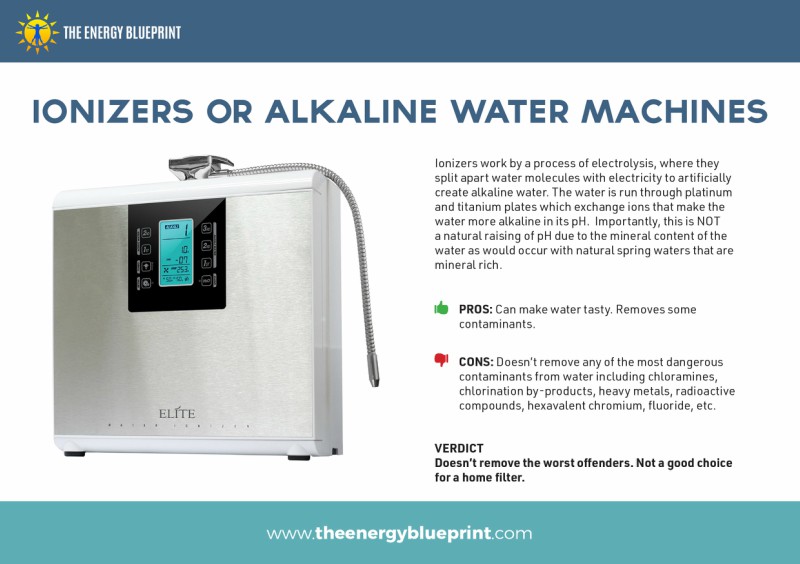 Ionizers are actually not really filters by themselves. To be clearer, the actually ionizing element of the device do very minimal filtering of contaminants.
Ionizers are actually not really filters by themselves. To be clearer, the actually ionizing element of the device do very minimal filtering of contaminants.
Ionizers work by a process of electrolysis, where they split apart water molecules with electricity to artificially create alkaline water. The water is run through platinum and titanium plates which exchange ions that make the water more alkaline in its pH. Importantly, this is NOT a natural raising of pH due to the mineral content of the water as would occur with natural spring waters that are mineral rich.
But most of the ionizers out there have some small charcoal filter element in addition to the ionizer element. Thus they are essentially the equivalent of simple pitcher style filters in terms of the contaminants they’re able to remove. That is, they are not capable of fully removing dangerous metals like arsenic, lead, mercury, and hexavalent chromium from water—nor are they able to remove all the fluoride, endocrine disruptors, or chloramines and dangerous chlorine by-products from your water.
Although they can reduce the amount of chlorine in your water they cannot remove
- VOCS
- Perfluorocarbons
- heavy metals
- fluoride
- chlorination by-products
Moreover, the charcoal pre-filter is usually small, which means that it will lose efficacy fast and be even less effective at removing the contaminants that charcoal is even capable of removing.
Also, there are several animal studies which have suggested harm from drinking ionized water. (See here, here, and here). But also some studies have suggested benefits.
Pros: Can make water tasty. Removes some contaminants.
Cons: Doesn’t remove any of the most dangerous contaminants from water including chloramines, chlorination by-products, heavy metals, radioactive compounds, hexavalent chromium, fluoride, etc.
Verdict: Doesn’t remove the worst offenders. Not a good choice for a home filter.
Gravity Filters with Solid Block Carbon Water Filtration Systems

Gravity filters are essentially like pitcher filters, but generally are made of stainless steel instead of plastic, and come with better filter elements that filter a wider range of contaminants. They generally use solid carbon block filters, which are able to remove a fairly wide range of contaminants.
The first thing I want to point out is that used alone, gravity filters such as carbon block filters are generally not very effective at removing hexavalent chromium (chromium-6) from water. Since some 37 states have a problem with hexavalent chromium in their water (and more will one day), I do not recommend this kind of filter alone for anyone living in a state with chromium-6 in their water.
The EPA finds carbon filters effective at removing VOCs, pesticides and herbicides, bacteria, and fluoride (when you use an additional fluoride filter).
Solid block carbon filters are typically used in large canister counter-top models where you pour gallons of water in them and wait for around 5 hours or so for the water to pass through the carbon filter and come out the spigot. Most people fill them with water at night and then wake up to filtered water in the morning.
You can take the portable canister with you anywhere, camping, traveling, hotels and assure you’ll have safe water wherever you go.
Pros: These filters remove VOCs, bacteria, chemicals, fluoride (when you add a fluoride filter), chlorine, chloramines, nitrates, nitrites, parasites, and other heavy metals. Does not require electricity. Infrequent filter replacement and filters are affordable.
Cons: Cannot remove hexavalent chromium. Cannot remove hormone-disrupting chemicals like BPAs, BPS, and others. Takes up a lot of counter space. Cumbersome to pack in a car. Has to be manually filled with gallons of heavy water. Takes 5 hours to filter the water. (I recommend the Berkey for gravity filter models). The standard filter elements are inadequate. You MUST pay extra and opt for the top of the line filter elements. You need extra filter elements to remove fluoride.
Verdict: A decent choice, but you need to get the top of the line filter elements and need to replace them often (every few months) to make sure they are actually working well enough to remove a large portion of contaminants form your water.
Bottled Water
While bottled water is technically not a filter option, I did want to briefly mention it as it is one option of getting clean drinking water. But it’s far from a perfect solution. Here’s why:
- Many bottled water companies actually just use tap water — the same water filled with all the contaminants mentioned here. And they frequently use methods of filtering that do NOT actually purify the water of all these contaminants, including some of the worst offenders.
- Water packaged in plastic bottles also causes further problems because the plastics themselves leach hormone-disrupting chemicals into the water, like BPA, BPS and phthalates.
- It’s considerably more expensive than filtering your own water at home.
Having said that, getting pure spring water (be aware that there are some scammy companies selling fake spring water that is not very pure) in glass bottles is a viable way to acquire clean and pure drinking water. The only downside is that it will be much more expensive than filtering your water at home.
Multi-Stage/Multi-Media (Counter-top or Under-Counter) Water Filtration Systems
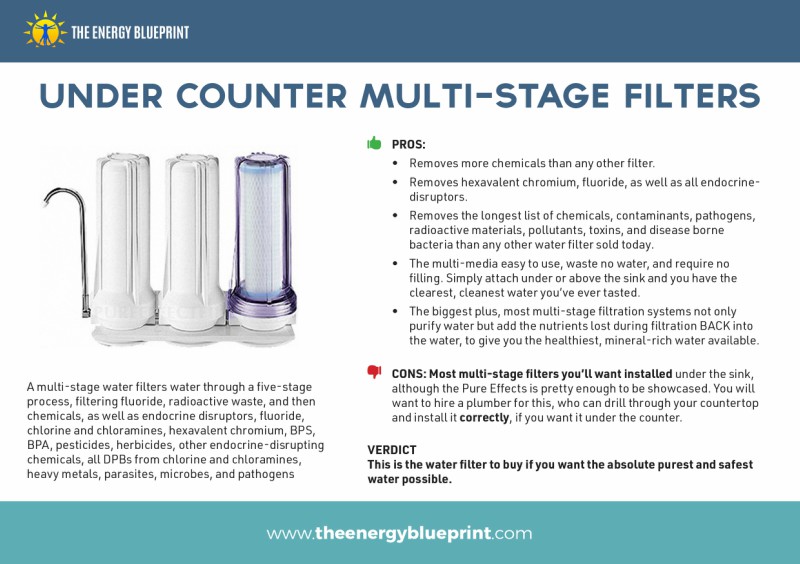
After years of research and trying all of the other options, I am going with what is called a multi-media water filter. It’s a five-stage filter that removes all contaminants and chemicals from water using five-stage process.
A multi-stage water filtration system filters water through a five-stage process, filtering fluoride, radioactive waste, and then chemicals, as well as endocrine disruptors, fluoride, chlorine and chloramines, hexavalent chromium, BPS, BPA, pesticides, herbicides, other endocrine-disrupting chemicals, all DPBs from chlorine and chloramines, heavy metals, parasites, microbes, and pathogens.
The Pure Effects multi-stage filters all the dangerous chemicals out of my water and leaves the purest water available to mankind in the process.
But here’s what makes the Pure Effects most unique. During this five-stage purification process, after removing every dangerous chemical and pathogen, the last stage of the process replaces all the NUTRIENTS in water. It adds back minerals to the water that are denatured during the filtering process. The end result is water that is loaded with
- Minerals
- Antioxidants
- electrolytes
Pros:
Removes more chemicals than any other filter.
Removes hexavalent chromium, fluoride, as well as all endocrine-disruptors.
Removes the longest list of chemicals, contaminants, pathogens, radioactive materials, pollutants, toxins, and disease borne bacteria than any other water filter sold today.
The multi-media easy to use, waste no water, and require no filling. Simply attach under or above the sink and you have the clearest, cleanest water you’ve ever tasted.
The biggest plus, most multi-stage filtration systems not only purify water but add the nutrients lost during filtration BACK into the water, to give you the healthiest, mineral-rich water available.
Cons: Most multi-stage filters you’ll want to be installed under the sink, although the Pure Effects is pretty enough to be showcased. You will want to hire a plumber for this, who can drill through your countertop and install it correctly if you want it under the counter.
Verdict: This is the best water filtration system to buy if you want the absolute purest and safest water possible.
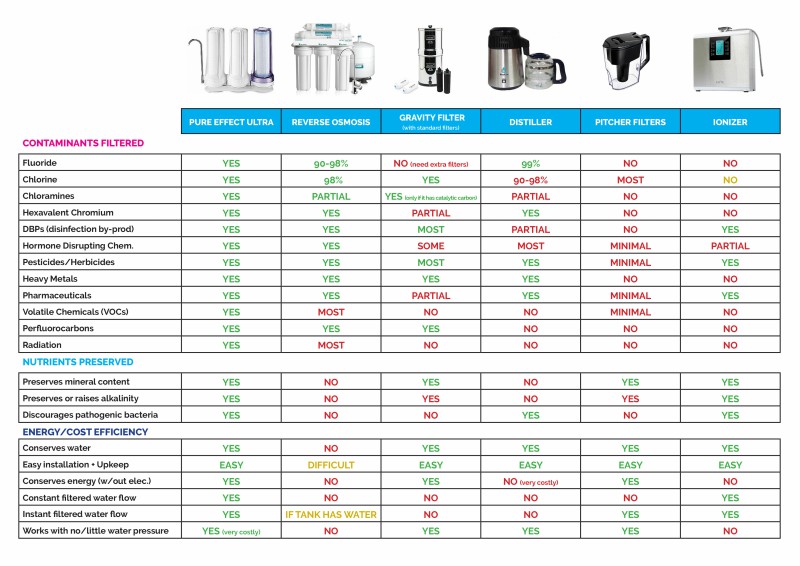
My Top Recommended Best Water Filtration Systems
1. The Pure Effect Ultra Under Counter or Counter-Top Filter
Most water filters concentrate more on getting contaminants, pathogens, and chemical out of your water—with little thought to how healthy the water will be after all this cleansing and removal is complete.
But Pure Effects does the exact opposite. Their goal wasn’t just to get the bad stuff out, but also leave the good stuff in. What they’ve accomplished is a five-step water filtration system that removes MORE dangerous chemicals, heavy metals, pathogens, PFCs, VOCs, fluoride, mercury, hexavalent chromium, endocrine disruptors—and even radiation while restoring the water’s mineral content, electrolyte content.
The Pure Effect comes in both an under the counter and countertop version, for those of you who don’t want to drill (a small hole) into your countertop for the spigot. They also make excellent whole house filters.
The Pure Effect Ultra is neither a reverse osmosis or gravity filter. Rather, it is a five-step filtration system designed to remove bacteria, viruses, radiation, heavy metal, toxins, chemicals, and contaminant imaginable. In short, it’s designed to give you the purest water possible.
Pros:
The Pure Effect Ultra removes
- Fluoride
- Pharmaceutical drug residues
- Viruses
- Bacteria
- Radioactive materials and runoff from chemical plants
- All heavy metals (arsenic, hexavalent chromium, lead, cadmium)
- Chloramines
- Chlorine
- Chlorine disinfection by-products
- VOCs
- PFCs
- Arsenic
- Fluoride
- Trihalomethanes
- Mercury
- Cadmium
- Hexavalent Chromium
- Disinfection-by-products
- Cysts
- Sediments
- Pesticides/herbicides
But beyond that it also
- restores the natural alkaline pH of water back to between 6.5 and 9.0 pH so your water is neither too acidic or too alkaline.
- Restores calcium, magnesium, and iron content to water after filtration
- Restores electrolytes to your water after filtration
- Reduces oxidant capacity in your water (reducing cell-destroying free radicals)
- improves your water’s antioxidant content by 25%. By donating electrons to protons, free radicals are reduced in your water. It’s the only water filter that improves your antioxidant potential.
- Greatly improves the taste and clarity of water
- Uses a technology called advanced Flow Regulation Technology. This ensures water does not pass through the system too quickly, and has sufficient contact time with filtration media, allowing optimal contaminant filtration.
- High-quality BPA and phthalate-free plastics, lead-free components and the highest-grade filters available on the market. Plus, all models and parts are manufactured solely within the USA.
- Comes with a 2-year no-hassle warranty.
- Requires no electricity (works solely through water pressure)
Cons:
The only significant drawback is that it’s not the cheapest filter. (But the cheaper options don’t filter out nearly as wide of a variety of harmful chemicals.)
This is the top option for home water filters.
I recommend their “ULTRA” model — either the countertop or under the counter model.
You can get that at the store here! (Note: They do ship internationally).
2. The APEC Reverse Osmosis system
 The APEC 5 Stage Reverse Osmosis Water Filtration system is a reverse osmosis system that removes 99% of ALL contaminants in water from heavy metals to chlorine and chloramines. Also viruses, bacteria, and thousands of other contaminants.
The APEC 5 Stage Reverse Osmosis Water Filtration system is a reverse osmosis system that removes 99% of ALL contaminants in water from heavy metals to chlorine and chloramines. Also viruses, bacteria, and thousands of other contaminants.
It is FDA certified and it produces particularly clear, fresh, sparkling water with a taste superior to bottled water.
This is an under the sink, point-of-entry or countertop filter—whichever you choose.
Pros: Removes over 95% of all chemicals and contaminants.
Cons: Although it is effective at removing pathogens and most dangerous chemicals from water, it also depletes the water of all its mineral content and can leach more minerals from the body because of this. It also removes electrolytes from the water.
Reverse osmosis filters also cannot remove radiation, volatile chemicals such as benzene, toluene, xylene, perfluorocarbons, perchloroethylene, tetrachloroethylene, gasoline, styrene, formaldehyde, or gasses.
Also, since the filter canisters are made of plastic and acidic water causes more plastic leeching, it is possible that the filter cartridges themselves can leech chemicals into the water.
Verdict: Effective at removing contaminants, but acidifies and demineralizes the water in the process.
3. Big Berkey with Black filter elements plus fluoride filters
This is a gravity filter that is top of the line for removing heavy metals, hexavalent chromium, pharmaceuticals, and a long list of the most harmful toxins in the water today. But it’s not without some drawbacks. I recommend these to my friends who travel, as you can take them anywhere and filter water at any hotel, lake, campsite—anywhere.
It also removes all VOCs (volatile organic compounds produced when chloroline combines with organic matter) including dangerous trihalomethanes.
It removes basically all heavy metals including chlorine, chloramines, fluoride, mercury, lead, arsenic, and all chemicals/contaminants. But it is not capable of removing more serious chemicals like hexavalent chromium, hormone-disrupting chemicals, radiation, chlorine, chloramines, and fluoride (unless you purchase separate fluoride filters). For a traveling water filter I highly recommend it but for my home, I want a filter capable of removing a wider range of health-harming cancer-causing chemicals.
Pros: A relatively portable filter that removes a wide range of chemicals and dangerous compounds from water.
Cons: If you’re worried about removing hormone-disrupting compounds and the more serious, cancer-causing chemicals, this is not the filter for you.
Verdict: Okay for traveling but not a choice for serious water filtration.
4. Megahome Water Distiller
Distilling is another option. But despite the reputation has for completely purifying water, it turns out that this really isn’t true. Taking water past the boiling point removes a large portion of a wide variety of chemicals. Unfortunately, as explained above, there are still numerous chemicals that have a lower boiling point than water that stay in the water.
However, I don’t recommend distilled water long-term as it’s completely devoid of minerals. It does produce some of the best tasting water you’ve ever had, though!
This can be a good option when traveling, but not for everyday home use.
Pros: Produces good tasting water and removes a wide range of contaminants and chemicals that are below the boiling point of steam.
Cons: Cannot remove any dangerous chemicals that have a lower boiling point than water, like hexavalent chromium. Also, it removes all minerals and electrolytes along with the contaminants.
Verdict: Not a choice for long-term water filtration as it could cause mineral deficiencies of several kinds and doesn’t filter out a wide enough variety of chemicals.
Conclusion and Summary – Best Water Filtration Systems
I know it’s frightening when you realize exactly how polluted our water really is. It’s even more frightening to realize that many of the most common chemicals in the water supply have not been screened for safety and are in fact, known to be toxic to human health. We’ve now seen that many of the chemicals commonly found in our tap water:
- Directly damage our mitochondria (cell energy generators), which is a major cause of chronic fatigue and accelerated aging.
- Contribute to cardiovascular disease
- Disrupt hormones in our body
- Damage brain cells and brain function (and hinder proper brain development in children)
- Contribute to cancer
Until then, let’s take care of ourselves and assure that we get clean, uncontaminated water that hydrates and vitalizes our bodies — not hurts them. You’re worth a good glass, tall, glass of water that you know won’t one day cause you or your family cancer. It’s that simple.
So use the guide above and go grab yourself a top water filter and start protecting your family’s health!


Sources
[1]EWG. (2016). ‘Erin Brockovich Carcinogen In Tap Water Of More Than 200 Million Americans.
[2]Scientific American. (2009). U.S. drinking water widely contaminated.
[3] Scientific American. (2009). U.S. drinking water widely contaminated.
[4] EWG’s Tap Water Database. State of American drinking water.
[5] EWG’s Tap Water Database. State of American drinking water.
[6]National Research Council (US). Systemic Exposures to Volatile Organic Compounds and Factors Influencing Susceptibility to Their Effects. Contaminated Water Supplies at Camp Lejeune: Assessing Potential Health Effects
[7] OAW Health. How to avoid the hidden danger lurking in your shower.
[8]EPA. (2001). The arsenic rule.
[9]Zierler, S. et. al. (1988). Bladder cancer in Massachusetts related to chlorinated and chloraminated drinking water: a case-control study. Archives of Environmental Health, 43(2): 195-200.
[10]Morris, R. D. (1995). Drinking water and cancer.
[11]Kumar Mishra, B. (2014). Human health risk analysis from disinfection by-products (DBPs) in drinking and bathing water of some Indian cities. Journal of Enviornmental Health and Scientific Engineering, 12: 73.
[13]EPA. Carbon-tetrachloride.
[14] Toxipedia. Potential health effects from exposure to VOC emissions.
[15]Minnesota Dept. of health. VOCs in tap water.
[16] EWG. 170 Million Americans Drink Radioactive Tap Water
[17] Harvard Health. Drugs in the water.
[18] Harvard Health. Drugs in the water.
[19]Tchounwou, P. B. (2012). Heavy Metals Toxicity and the Environment. EXS, 101: 133–164.
[20]Jaishankar, M. (2014). Toxicity, mechanism and health effects of some heavy metals. Interdisciplinary Toxicology, 7(2): 60–72.
[24] EWG. Chromium 6 found in U.S. tap water.
[25]EWG. Chromium 6 in drinking water.
[26]Carex Canada. Chromium, hexavalent.
[27]Scientific American. (2009). Chromium in drinking water causes cancer.
[28] Brennan, D. (2016). Is chromium in water a health risk? San Diego Tribune.
[29] Brennan, D. (2016). Is chromium in water a health risk? San Diego Tribune.
[30]Clean Water Action. The dangers of hexavalent chromium.
[31] Clean Water Action. The dangers of hexavalent chromium.
[32] Harvard School of Public Health. Impact of fluoride on neurological development in children.
[33]Miyazaki, H. (1996). Changes in caries prevalence in Japan. European Journal of Oral Science, 104(4 ( Pt 2)):452-8.
[34]Kalsbeek H. (1993). Caries Experience of 15-Year-Old Children in The Netherlands after Discontinuation of Water Fluoridation. Caries Research, 27:201–205.
[35] U.S. Department of Health and Human Services Federal Panel on Community Water Fluoridation. (2015). U.S. Public Health Service Recommendation for Fluoride Concentration in Drinking Water for the Prevention of Dental Caries
[36] Chandrajith, R. (2010). Chronic kidney diseases of uncertain etiology (CKDue) in Sri Lanka: geographic distribution and environmental implications. Environment and Geochemical Health, 33(3):267-78.
[37] Chandrajith R. (2011). Dose-dependent Na and Ca in fluoride-rich drinking water–another major cause of chronic renal failure in tropical arid regions. The Science of Total Environment, 409(4):671-5.
[38] Liu, JL, (2005). The dose-effect relationship of water fluoride levels and renal damage in children. Wei Sheng Yan Jiu. 34(3):287-8.
[39] Czerwinski E. (1998). Bone and joint pathology in fluoride-exposed workers. Archives of Environ Health. 43(5):340-3.
[40] Paiste, M. (2012). Total knee arthroplasty in a patient with skeletal fluorosis. Orthopedics. 2012 Nov;35(11):e1664-7.
[41] Chen H, (2012). Spatial distribution and temporal variation of high fluoride contents in groundwater and prevalence of fluorosis in humans in Yuanmou County, Southwest China. J Hazard Mater. 235-236:201-9.
[42] Savas S (2001). Endemic fluorosis in Turkish patients: relationship with knee osteoarthritis. Rheumatology International. 21(1):30-5.
[43] P. Roschger, P. (1995). Bone mineral structure after six years fluoride treatment investigated by backscattered electron imaging (BSEI) and small angle x-ray scattering (SAXS): a case report. Bone (Impact Factor: 3.82). ] 16(3):407-407.
[44] Bang S, (1985). Distribution of fluoride in calcified cartilage of a fluoride-treated osteoporotic patient. Bone. 1985;6(4):207-10.
[45] FluorideAlert.org. Thyroid. (last accessed (01-10-2014)
[46] Merck & Co. The Merck Index, 1968 Edition. Rahway NJ. USA. (last accessed (01-10-2014)
[47] Zeng Q, (2012). Studies of fluoride on the thyroid cell apoptosis and mechanism. 46(3):233-6.
[48] Dr. Izabella Wentz, The Thyroid Pharmacist 2015 Fluoride And Your Thyroid
[49] Luke J. (2001). Fluoride deposition in the aged human pineal gland. Caries Research. 35(2):125-8.
[50] Freni SC. (1999). Exposure to high fluoride concentrations in drinking water is associated with decreased birth rates. Journal of Toxicology and Environ. Health. 42(1):109-21.
[51] Susheela, A.K. (1996). Circulating testosterone levels in skeletal fluorosis patients. Journal of Toxicology and Clinical Toxicology, 34(2):183-9.
[52] Varol E, Varol S. (2012). Effect of fluoride toxicity on cardiovascular systems: role of oxidative stress. Archives of Toxicology. 2012 Oct;86(10):1627.
[53] Ma, Y. et. al. (2012). Inflammatory responses induced by fluoride and arsenic at toxic concentration in rabbit aorta. Archives of Toxicology, 86(6):849-56.
[54] Choi, A. l. et. al. (2012). Developmental fluoride neurotoxicity: a systematic review and meta-analysis. Environmental Health Perspectives, 120(10):1362-8. https://www.ncbi.nlm.nih.gov/pubmed/?term=PMC3491930
[55]Tang, Q. Q. (2008). Fluoride and children’s intelligence: a meta-analysis. Biology and Trace Element Research, 126(1-3):115-20.
[56] Batenburg, J.J. et. al. (1972) The mechanism of inhibition by fluoride of mitochondrial fatty acid oxidation
[57] Hindawi (2012) Molecular Mechanisms of Cytotoxicity and Apoptosis Induced by Inorganic Fluoride
[58] Fina B.L. et. al. (2014) Fluoride Increases Superoxide Production and Impairs the Respiratory Chain in ROS 17/2.8 Osteoblastic Cells
[59]Elobeid, M. A. et. al. (2008). Putative Environmental-Endocrine Disruptors and Obesity: A Review. Current Opinion In Endocrinology, Diabetes, And Obesity.
[60]Kozisek, F. Health Risks From Drinking Demineralised Water.
[61]WHO. Nutrients in drinking water.
[62]Morris, R. D. (1995). Drinking water and cancer. Environmental Health Perspectives, 103(Supplement 8): 225-231).





